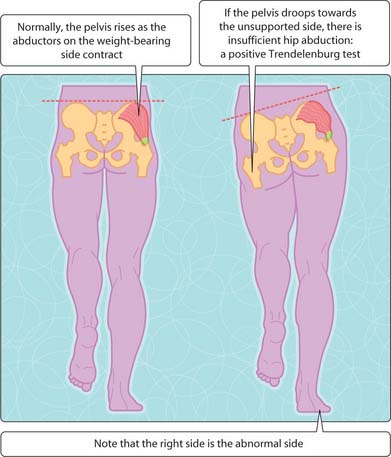59 Hip examination
Hip OSCE stations most often involve a painful hip caused by arthritis or a limping child (Ch. 64). Hip pain is typically in the groin but may be referred to lower back or knee; buttock pain is associated with lower back problems.
Look
The patient is examined lying flat for muscle wasting (quadriceps), arthroplasty scars (look at the back of the hip and buttock for posterior scars), sinuses (indicating deep infection), fixed flexion deformities and obvious leg length discrepancy. The patient is examined walking to assess posture, pelvic tilt and walking aids. Gait disorders include the Trendelenberg gait, which is a waddle caused by swinging the affected leg out, and the atalgic gait, where less time is spent weight-bearing on the affected side. The Trendelenberg test (Fig. 3.59.1) assesses hip stability. Causes of a positive test include osteoarthritis and rheumatoid arthritis (hip pain), non-union of a neck of femur fracture (shortened femoral neck), weak or paralysed abductors (nerve damage, polio) or lack of a fulcrum owing to hip subluxation or dislocation.
< div class='tao-gold-member'>
Stay updated, free articles. Join our Telegram channel

Full access? Get Clinical Tree









